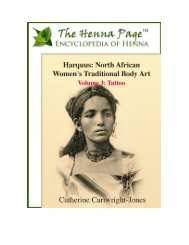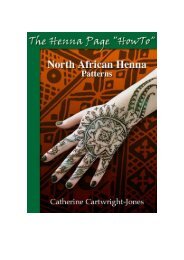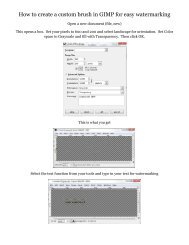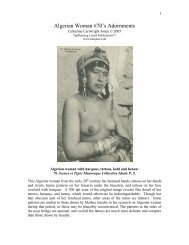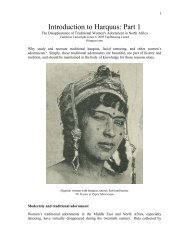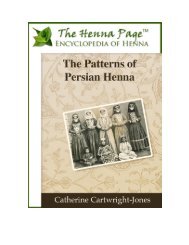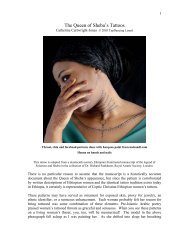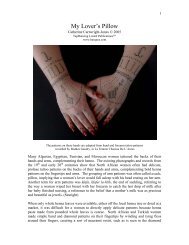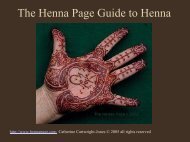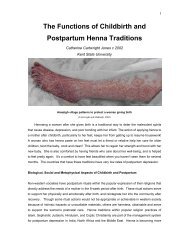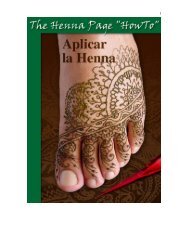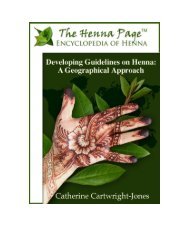Menstruation and Henna: Pollution and Purification - The Henna Page
Menstruation and Henna: Pollution and Purification - The Henna Page
Menstruation and Henna: Pollution and Purification - The Henna Page
You also want an ePaper? Increase the reach of your titles
YUMPU automatically turns print PDFs into web optimized ePapers that Google loves.
<strong>The</strong> justification for abstinence during menstruation <strong>and</strong> purification following is that menstrual<br />
blood is dangerous to the man <strong>and</strong> to unborn children. A man may <strong>and</strong> should approach a wife<br />
sexually who has purified herself of menstrual blood at the end of her cycle. Visible marks of<br />
purification, such as henna, demonstrate that the bearer’s vagina is again safe for entry, <strong>and</strong> that<br />
she is worthy of divine approval.<br />
Because of her impurity during her menstrual cycle, a woman cannot perform many aspects of<br />
her spiritual life. She may not pray during menses, as the prayers from an impure person have no<br />
consequence. She may not touch the Qur’an. She may not circumambulate the Q’aba on a<br />
pilgrimage to Mecca. She may not fast during her menstrual days during Ramadan, though she<br />
may fast later during the year to make up these lost days. She should not visit the musallah,<br />
where prayers are performed in the mosque.<br />
<strong>The</strong> purification following a menstrual cycle, ghusl, must be thorough, <strong>and</strong> the procedure is<br />
described in Islamic texts such as <strong>The</strong> Book of Taharah, “cleanliness”, from ‘Nur al Idaah’,<br />
Imaam Shurnbalali's Fiqh Manual: when a woman’s menstrual cycle is ended, determined by<br />
inserting a bit of cotton cloth into the vagina <strong>and</strong> finding it clean on removal, she was to perform<br />
a purifying bath, a ghusl, which includes washing the entire body, including the head.<br />
Cleanliness <strong>and</strong> hygiene are clearly significant issues for menstruation in Islamic life, <strong>and</strong> the<br />
necessity of ghusl following menstrual cycles <strong>and</strong> other events of bodily pollution are<br />
universalized across the Islamic world, as they are a matter of faith. <strong>The</strong>y were particularized<br />
locally, in regional practices of bathing <strong>and</strong> henna patterning preferences.<br />
Cleanliness in Islamic Marriage: <strong>Henna</strong> <strong>and</strong> Ghusl<br />
“<strong>Menstruation</strong> <strong>and</strong> <strong>Henna</strong>, <strong>Pollution</strong> <strong>and</strong> <strong>Purification</strong>”, was written by Catherine Cartwright-Jones as partial completion<br />
of the requirements for a Master’s degree in Liberal Studies focusing on henna, under the supervision of Dr. A Smith<br />
<strong>and</strong> Dr. N Ammar, Kent State University, Kent Ohio, USA<br />
16



